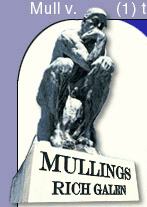

How a Bill Becomes Law
Rich Galen
Monday February 9, 2009
Click here for an Easy Print Version
Article 1 of the Constitution of the United States has to do with the Legislative Branch. Article II is about the Executive Branch; Article III is about the Judicial Branch. There are seven Articles in all, but you'll have to look those up if you want to know what they are.
Section 1 of Article I states in its entirety:
All legislative Powers herein granted shall be vested in a Congress of the United States, which shall consist of a Senate and House of Representatives.
The Constitution also commands that tax bills must originate in the House but other than that the legislative process is a free-for-all. Except for you and me. It is not free for you and me. We have to pay the taxes which pay for what the House and Senate members do.
After the House and the Senate have adopted a piece of legislation it goes to the President who may sign it, veto it, or do nothing in which case it becomes law after 10 days (excluding Sundays, and assuming the Congress hasn't adjourned) without his signature.
The reason for this discussion is because of H.R. 1 which is popularly known as The Stimulus Package. In our lesson about how a bill becomes law this is instructive. You could win many a bar bet on what the official short title is of H.R. 1. It is:
American Recovery and Reinvestment Act of 2009.
But you could win EVERY bar bet, including in every bar on Capitol Hill, if you asked what the official name of this thing is. Ready?
Making supplemental appropriations for job preservation and creation, infrastructure investment, energy efficiency and science, assistance to the unemployed, and State and local fiscal stabilization, for fiscal year ending September 30, 2009, and for other purposes.
Pretty snappy, huh?
And I love that "and for other purposes" catch-all at the end.
The House started this process and passed its version on January 28. The Senate picked up the ball after the House voted and has been messing with it ever since.
It is expected that the Senate will vote on its version today or Tuesday.
The Senate version and the House version are very different bills. But only one bill can go to the President for his action so what's the Congress to do?
What the Congress does is set up a special committee - and you will hear this a great deal in the next week - called a "Conference Committee" to hammer out the differences. The members of the Conference Committee - called Conferees - are chosen by the party leaders in each Chamber.
The assumption is, that language which is identical in each version will stay as is. No language will be added if it didn't come out of either bill. The Conferees will only deal with items which are in one version but not the other.
Like so much of what goes on in the Congress these rules are, as they say, largely honored in the breach.
Language which is identical in both the House and Senate bill is often changed (or deleted) by the Conferees. Language which does not exist at all, is often inserted by the Conferees (this is where much of the "earmark" skullduggery takes place). Language which is in one bill but not the other might just be dropped altogether as the agreements, swaps, deals, and trade-offs are worked out.
At some point the Conferees (and their staffs) will agree on the text of the bill and produce what is known as a "Conference Report." This is the agreed-upon language and goes to each chamber for an up-or-down vote. Conference reports are not amendable.
Assuming both the House and the Senate agree to the Conference Report on any given bill, it is signed by the Speaker of the House and the President Pro Tempore of the Senate and trucked on up to the White House so the President can act on it.
If the President vetoes a bill, it takes a 2/3 vote of each Chamber to override that veto which doesn't happen very often.
The only other group which gets a say in this law-making biz is the Supreme Court of the United States. In the case of Marbury v Madison (1803) established the right of "judicial review." That means the Court can declare a law - or a section of a law - as being contrary to the Constitution and making it invalid.
I knew that because I actually attended most of Dr. Robert Hill's Con Law classes at Marietta College, Marietta, Ohio 45750.
That, class, is how a bill becomes law.
On the Secret Decoder Ring today: A link to the Library of Congress' version of this same topic and a link to a page about Marbury v Madison. Also a Mullfoto from the garage at Reagan National Airport and a Catchy Caption of the Day.
--END --
Copyright © 2009 Barrington Worldwide, LLC
Become a
Paid Mullings Subscriber!
(To join the FREE mailing list or to unsubscribe Click Here)

Current Issue |
Secret Decoder
Ring | Past
Issues | Email
Rich | Rich
Who?
Copyright �2006 Richard
A. Galen | Site design by Campaign
Solutions. |





 US & Int'l Papers
US & Int'l Papers